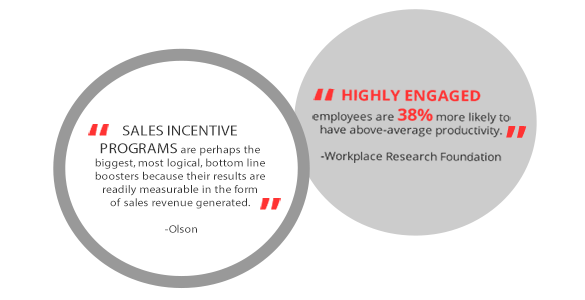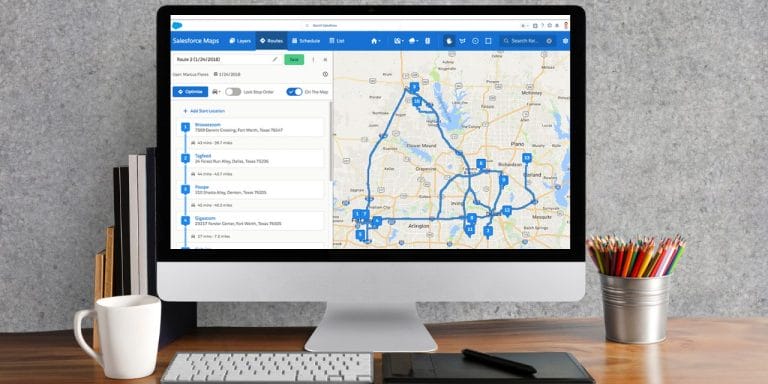About 80% of sales can be attributed to 20% of a sales team. That doesn’t necessarily mean that the underperforming majority is unqualified. Often, poor sales performance occurs due to lack of motivation. Sales incentives programs could be the solution to that problem.
In this post, we’ll take a look at how to motivate sales reps, how to reward top performers, and mistakes to avoid when implementing a sales incentive program. Let’s get started!
What Is A Sales Incentive Program?
A sales incentive program is a system that rewards salespeople who meet specific goals. Rewards may be monetary — such as bonuses — or non-monetary. Sales incentive programs are supplemental to the standard compensation structure and are designed to motivate salespeople to exceed their usual performance metrics.
5 Types Of Sales Incentives
Sales incentives should be customized based on business objectives, the makeup of a sales team, and other factors. Following are five potential ways to motivate reps:
1. Role-specific
Sales incentives should be structured in a way that they suit specific roles. For example, a rep who specializes in closing deals would have different goals than a rep who focuses on prospecting. For a team like this, running concurrent sales incentive programs for different sales rep types might be the best approach.
2. Territory-based
In some cases, a territory-based sales incentive program may be a good way to motivate sales teams. In such a scenario, reps working the same territory get an equal share of total commissions. This type of program may exert just enough social pressure for underperformers to hit new sales goals.
3. Presales
In products with a long sales cycle — such as enterprise-level software — sales incentives may need to be structured around incremental goals instead of closed deals. For example, incentives could be tied to scheduling product demos for potential customers, so sales reps stay motivated while customers mull over whether to purchase software.
4. Omnichannel
In some sectors, the sales process may begin with a sales rep and end when a lead makes a purchase online. Omnichannel incentives account for this, by tracking a closed sale back to the rep or reps who originally got a prospect into the sales funnel.
5. Analytics-based
Analytics can help companies analyze sales rep behavior and define sales goals more granularly. So, in the case of field service reps, analytics could reveal that some reps close deals in less time than others.
The key to any successful sales incentive program is understanding what motivates people, which we’ll cover in the next section.
Understand What Motivates People
Sales professionals have some characteristics in common, but treating them as a group without accounting for what motivates them individually isn’t the way to successfully implement a sales incentive program.
Harvard Business Review suggests companies recognize these differences and adjust their sales incentives to address them. Viewing the sales team “like a portfolio of investments that require different levels and kinds of attention” elicits improved performance across the team, from your seasoned salespeople to your rookies.

Different Approaches For The Three Sales Rep Types
Generally, sales reps fall into one of three categories:
- Laggards — These are the people who are consistently underperforming.
- Core performers — These are the “slow-and-steady” reps who are reliable, yet perhaps not achieving their full potential. They account for the majority of any sales team.
- Stars — These are the top performers in any sales team.
You should individualize your sales incentives programs for the type of salesperson you wish to motivate. And remember — don’t neglect your top performers as you look to motivate their underperforming peers.

So, what inspires each of three groups, stars, core and poor performers? Here’s what Harvard Business Review says works best for each of our three groups:
Star Performers: Standard Incentive Plans
Top performers respond well to a traditional sales incentives program (e.g., trips, cash, and recognition at the annual meeting). If you only want to get more sales from the people who bring you the most deals, then using a tried and true incentive program will likely do the trick.
However, since one of the stars will undoubtedly claim the top prize, and because the other two groups know this, traditional incentive programs will be less useful for the other two groups.
Core Performers: Tiered Incentive Plan
Tier 1 incentives should be based on sales levels that have historically been easy to achieve. Tier 2 incentives should be based on sales levels that fewer sales reps have historically reached. Tier 3 incentives should be based on sales goals expected of star performers. This tiered structure can be effective in developing core performers into stars.
Laggards: ‘Carrot And Stick’ Plans

For those who rarely hit their numbers — either due to lack of motivation or inexperience — rewards alone may not be enough to achieve the desired results. A better approach may be to use a balance of “carrot and stick” (positive and negative reinforcement).
The carrot is the positive reward that pulls people forward toward sales goals — a bonus, a new territory, or recognition, for example. The stick is the pressure that pushes sales reps, such as a performance improvement plan (PIP).
Fundamentals Of Effective Sales Incentive Plans
A significant factor in a sales incentive plan’s success is its simplicity. Like all people, salespeople like clear expectations that are easy to understand. When forced to sort through options and categories and formulas, people tend to feel frustrated. Ultimately, they lose interest and return to an activity they know works.
These are the fundamentals of effective sales incentive plans:
Clear goals and easy calculations: It is vital that the sales incentive program be clear and simple to understand, with a defined prize. If the program is too complicated, many of your team members won’t bother.
Rewards for specific sales activity: Your sales incentives program should reward the activity you want sales reps to incorporate in their sales cycle, such as upselling to existing customers or signing new service agreements.
Allows for multiple winners: If only the top performer wins, then those whose performance is typically below star-level won’t be motivated to participate in the contest. Having more than one winner helps motivate sales teams.
Significant and immediate rewards: The longer your team has to wait for the reward, the less motivating it becomes. The Balance encourages sales managers to keep the time between “winning and getting,” short.
No caps on earnings: To motivate your stars, it is critical that no cap exists on their compensation. Putting a limit on what a star can earn is the fastest way to get them to stop selling.
Includes pace-setting bonuses: A pace-setting bonus, such as a quarterly bonus, is effective at keeping your sales team on track, particularly your lowest performers. It serves as a periodic performance check-in that keeps them focused on the goal.
Uses social pressure elements: Social pressure influences people to change their behavior based on what their peers are doing. An example of using social pressure in the sales incentive plan is to post the standings daily or weekly where everyone can see it.
Using this type of social pressure can motivate activity in the lowest performers. It can also ignite a competitive spirit among your core group and reward your stars with one of their favorite prizes: recognition.
Non-monetary rewards: Money isn’t everything, so offer a mix of rewards based on what motivates your team. (We’ll provide some examples of different rewards in the next section).
10 Ideas of Sales Incentive Programs
A Billboard.
Ambition, creators of a proprietary sales management platform, ran a month-long sales contest with the prize being a billboard in any location filled with the winner’s choice of content. The strength of the incentive made this one of the company’s most successful sales incentive schemes.

Special Wardrobe Pieces.
Ambition also had success when they ran a sales contest to win the “Green Jacket” right around The Masters Tournament. Per their chief sales officer, perhaps equally important to the jacket were the bragging rights that came along with it.
An Extra PTO Day.
Who doesn’t want more time off? Increase the appeal of this incentive by offering it after a quarter-end or a time-consuming project.
Provide VIP Parking For The Month.
Preferred parking makes a statement to the team, and it’s an added convenience for sales reps.
More Time In The Limelight.
Few people like the spotlight more than salespeople. Being the champion of the team is a high honor, so salespeople work hard to get it. Something as simple as recognition from the president in front of the company can do wonders for your team’s motivation.
An Excellent Swag Bag Giveaway.
From technology gadgets to clothing to assorted merchandise, never underestimate the power of goods to get the best services from your people. One cable TV company assembled a swag bag with all the best merchandise from various channels (HBO, ESPN, TNT, and more) that had salespeople working overtime to take home.
Hard-To-Get Tickets To A Special Event.
A radio station in the Midwest once awarded their top salesperson for new business development tickets to the major-league baseball team’s opening day. Even salespeople that weren’t baseball fans worked hard to earn those sought-after seats.
Family-Oriented Incentives.
Whether it’s a special dinner out at a fine dining restaurant or tickets to a local theme park, salespeople like sharing their success with family and friends.
Hand Out Family-Oriented Incentives.
Whether it’s a special dinner out at a fine dining experience or tickets to a local theme park, salespeople like to take their families out to celebrate their success. Being a hero to the kids, or a vaunted cousin can light a fire for many salespeople.
Lunch With The Executives.
Salespeople are ambitious. Time in front of senior management can be hard to get, especially in large corporations. Offering a lunch out with executives can be an exceptional motivator for employees that have their sights set high in the company says Xactly.
Creating A Foundation For Success
A couple of years ago, Fast Company reported research from the University of Warwick that found happy workers are 12% more productive and unhappy workers were 10% less productive. The researchers asserted that companies that invest in employee support have happier workers. So supporting your team is a good way to cultivate employee engagement and peak performance.
Also, sales managers should explain the company’s mission and emphasize to the team how their roles contribute to that mission. Knowing these details and feeling engaged with the company will help your salespeople feel important and appreciated, as well as emotionally invested in what you are trying to accomplish.

For incentive plans to work, your team needs to trust you. They cannot be happy, feel supported, and engaged with the company mission if they don’t believe in their boss. To build trust, you need to tell your team the truth and keep your promises. You’re not just a sales manager, you are a coach — you help your team solve problems.
Working with your team members on an individual basis, recognizing what comes naturally to them, and helping them find solutions for their challenges can form deep bonds of trust that result in employee engagement.
5 Mistakes to Avoid When Launching a Sales Incentive Plan
Up to this point, we have examined what you should do. Now, let’s take a look at some of the things you should not do. After all, why not learn from other people’s mistakes? To that end, here are a few tips on what not to do with your sales incentive plan management.
1 | Not getting input from the team.
You know many things, but you don’t know everything. Your team knows what is possible; they also know what is not possible. Share your goals for the program and what you want to get from it. Then, see what ideas they have to get you there and what they want as a reward.
Be careful, however. If you scale the sales incentive plan back from what your team told you they wanted, your incentive plan can have the opposite of your desired effect—and damage the trust you have worked hard to build.
2 | Allowing for only one winner.
If you have one winner, someone who is not a top performer knows they do not have as much of a chance as a star performer. When you have a plan with more than one winner, it promotes team spirit and encourages an atmosphere of collaboration.
A supportive team can reap excellent rewards long term. As Steve Jobs said, “Great things are never done by one person. They’re done by a team of people.”
3 | Having a one-size-fits-all incentive plan.
Different salespeople like different types of rewards. Therefore, it is crucial to diversify the awards to increase sales incentive’s plan appeal to all kinds of salespeople.
4 | Launching the plan and then never discussing it again.
For a sales incentive plan to motivate your team, you should have it be a regular part of their day. As Forbes suggests, you should have daily reports on their results. Depending on your strategy, you could even have a chart you update with all the team’s performance on it.
However, if you do not update the team, they will forget about it— and forget about putting in the effort you need them to as well.
5| Dragging it out too long.
People have short attention spans. They like quick wins, even when the victory is not as substantial. Incentive Solutions, recommends that your sales incentive plan can have long-term goals, but it’s a good idea to have some short-term goals there also to keep your team motivated.
The Bottom Line
The bottom line is that the right sales incentive program can have a big impact on performance — and profits.. From regular compensation structure to select programs for specific goals, sales incentive plans can motivate your employees and increase sales.
Remember that different incentives motivate your salespeople. It is your job to match the program to the individuals. That could mean you have a few different plans throughout the year and different levels of achievement to include all the salespeople segments.
Whatever you decide, be sure to sell the benefits to the team to get their buy-in on the program. The sales incentive plan is vital to getting the results you need, but so is your contribution. By creating the right culture, fostering employee engagement, and establishing a relationship of trust, you have built a solid foundation for your sales incentive plan to succeed.
_____
SPOTIO is the #1 field sales engagement and performance management software that will increase revenue, maximize profitability, and boost sales productivity.
Want to see a product demonstration? Click here to see how SPOTIO can take your sales game to the next level.
______________________________________________________
Sources:
Shearstone, Paul. “How to Create Sales Incentive Programs That Work.” Thebalancesmb.com. 22 January 2018. Web. 11 June 2018. < https://www.thebalancesmb.com/how-to-create-sales-incentive-programs-that-work-2947169>.
Steenburgh, Thomas; Ahearne, Michael. “Motivating Salespeople: What Really Works.” Hbr.org. July-August 2012. Web. 11 Jun 2018. <https://hbr.org/2012/07/motivating-salespeople-what-really-works?cm_sp=Article-_-Links-_-Comment>
McNulty, John. “The Sizzle.” www.newyorker.com. 15 April 1938. Web. 11 June 2018. < https://www.newyorker.com/magazine/1938/04/16/the-sizzle>>
Patel, Sujan. “6 Ways to Motivate Your Sales Team.” Inc.com. 9 Dec. 2017. Web. 11 June 2018. < https://www.inc.com/sujan-patel/6-ways-to-motivate-your-sales-team.html>.
Revesencio, Jonha. “Why Happy Employees are 12% More Productive.” www.fastcompany.com. 22 July 2015. Web. 12 June 2018. https://www.fastcompany.com/3048751/happy-employees-are-12-more-productive-at-work.
Carroll, Beth. “Top Sales Compensation Mistakes (And some good ideas, too).” Mtshrm.org. Web. 12 June 2018. From pdf: < http://mtshrm.org/images/downloads/2014CompSym/top_sales_compensation_mistakes.pdf>.
Fotsch, Bill; Case, John. “The Four Mistakes That Will Kill Your Incentive Plan.” www.forbes.com. 11 May 2016. Web. 12 June 2018. https://www.forbes.com/sites/fotschcase/2016/05/11/the-four-mistakes-that-will-kill-your-incentive-plan/#740767af36f4.
Gunn, Nichole. “Avoid These 7 Common Sales Incentive Mistakes.” www.incentivesolutions.com. 1 April 2015. Web. 12 June 2018. < https://www.incentivesolutions.com/2015/04/01/avoid-these-7-common-sales-incentive-mistakes/>.





